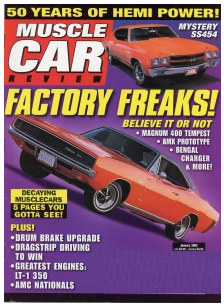1968 Dodge Bengal Charger Edition
Welcome to the latest edition of Muscle Car Milestones. Here, we look at not just cars, but trucks, SUV’s, and any other vehicles that have become legendary, notorious, and maybe even loathed in the muscle car world. We will also take a look at the rare, forgotten, and just plain overlooked muscle from all eras. There are no rules or limitations as to what we will cover. This edition of the Muscle Car Showcase highlights the 1968 Dodge Charger. The second generation Charger was all-new for 1968 and so were the Cincinnati Bengals. Our story focuses on an enterprising dealer and how he created the perfect tribute car to the newly created football team.
In 1968, the American Football League (AFL) granted the city of Cincinnati a football franchise called the Bengals. To commemorate the occasion, local Dodge dealer Tom Kneer decided to create his own special edition Dodge Charger in the team’s colors. He then made contact with the Bengals’ headquarters to get this vital piece of information needed to craft his Bengal Charger. He discovered the team’s uniforms were black with orange and white stripes and helmets were bright orange with black “Bengal” lettering. Now it was time to put his idea in motion and place the order with Dodge for 50 of the limited edition cars.
Tom scanned through a multitude of paint samples in Dodge’s color guide to find a shade of orange that best matched the Bengal’s hue. He discovered an orange used for Michigan state fleet vehicles that would work for his order. Even though the color was known as PPG 60326, he dubbed the color Tiger Orange. Since black was also part of the team’s colors, black vinyl tops were ordered to complement the orange paint. Dual black stripes with accents on the rear quarters and trunk rounded out Tom’s specifications for his Bengal Charger. Because Tom was purchasing so many cars, Chrysler agreed to throw in the black Sport Stripes for free. In 1968, Chrysler put Sport Stripes on the Charger R/T only. Since most of the Bengals were not R/Ts, obviously, an exception was made. For this reason and because they were free, the stripe does not appear on the broadcast sheet but instead was part of the special order precessing along with the orange paint. Other than ordering 100 specially fabricated fender badges with a “Bengal Charger” inscription, which were made in Cincinnati and applied at the dealership, no other body modifications were made to the car. The package also included unique floor mats with Bengal Charger lettering in orange, but there's no info on whether these were added by Dodge or the dealership. Every Bengal was built at the Hamtramck, Michigan assembly plant.
All Bengal Chargers were ordered from the factory with black or white interiors. Some Bengal Chargers were heavily optioned including amenities such as air conditioning, woodgrain steering wheel, 8-track stereo, and tachometer. As opposed to the exterior, Tom had no special badging applied to the interior of the car. Depending on how much customization was done by the customer, a nicely equipped car could cost close to $5,000. This was quite a significant amount of dough for 1968.
Tom knew buyers would want choices when it came to engines that could be ordered for their Bengal Charger. Shoppers could choose powerplants ranging from an asthmatic 225 cubic-inch 6-cylinder sporting only 145 horsepower all the way up to a powerful V8 touting over 300 horsepower. In fact, most cars were ordered with either the 318 or 383 cubic inch V8 engines. Sadly, none were ordered with the 425 horsepower 426 Hemi. This is supposedly due to the high markup associated with this tire shredder.
It appears that Tom placed ads in the local newspaper advertising the Bengal Chargers. The ad states that the car is a special build to commemorate the new football team. The ad also mentions that 30 cars are available out of the 50 that were built.
Once the special edition Chargers arrived at the dealership, team owner Barry Buse purchased one and quarterback Jim Stoffa received one to drive for a year. All 50 Bengals were sold before the team had ever played a game. Most of them have practically disappeared. Fast forward to the present and a few examples of the rare car are known to exist. An article in the January 2002 edition of Muscle Car Review states that only three of the unique Chargers have been accounted for in recent years. One was prominently featured on the cover for the issue.
Mopar experts claim that only three are still known to exist and, needless to say, they rarely show up in public. And if you want to buy a Bengal Charger you need a ton of good luck to find one for sale or going under the hammer.
Apparently, one car was auctioned off for charity back in 2001 and resurfaced at Mecum Auctions' Kissimmee sale in early 2020. Even though it was estimated to fetch more than $280,000, the Charger changed hands for just $80,300.
https://horsepowermemories.com/2014/08/05/1968-dodge-charger-bengal-edition/
Jeff Warner, a central Ohio native, discovered this rare Bengal in 1992 and found out that even the most ‘in-the-know” Mopar enthusiasts had almost no knowledge of the Bengal whatsoever. Jeff’s surviving example of the Bengal Charger species is a highly significant piece of Mopar history. Adding to its uniqueness, this particular Bengal is also uncommonly loaded with options. Galen Govier, nationally recognized Mopar guru, stated; “This is one of, if not the highest optioned ’68 Chargers I have ever seen! Whoever ordered this car must have said, order everything on the list!” Jeff’s Bengal has been featured in many popular automotive magazines and has won numerous show awards. It has been featured in parades and at Cincinnati Bengals players’ benefits.
















No comments:
Post a Comment